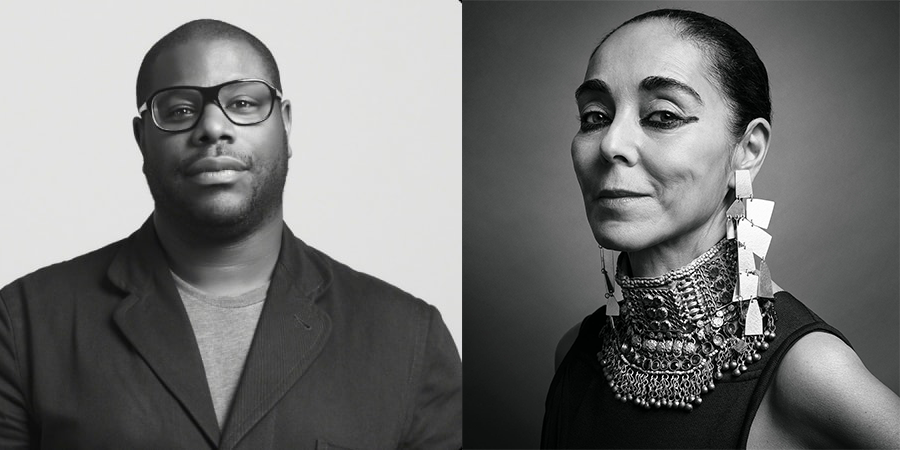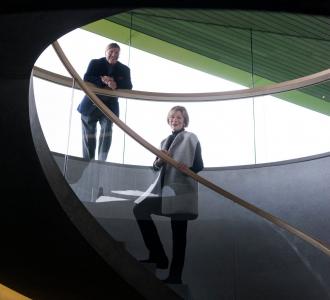After taking a class that introduced her to a wide range of art and design forms represented at Berkeley and beyond, interdisciplinary studies student Michelle Williams ’22 began cataloging the legacy of her own family’s art collection. “My mother was a prolific fine artist.… The slides alone are in the thousands!” says Williams. “What has moved me so much is experiencing the translation of human emotions through the various forms of time-based media.”
Hosted by the Berkeley Arts + Design Initiative, the flagship course is offered in conjunction with Arts + Design Thursdays, a public lecture series featuring leading media artists, curators, and thinkers each week. The spring 2021 series was supported by a generous gift from the Kramlich Art Foundation, the foundation’s first major gift to a university. Established and directed by Cal alumna Pamela Kramlich ’64, the foundation is one of the most influential private collections of new media and time-based art in the world, with a focus on audiovisual technology and performance since the 1960s. Time-based art includes video, film, slides, audio, and computer technologies that unfold to a viewer over time.
Kramlich’s support provides meaningful opportunities for students to gain exposure to the arts, furthering the initiative’s goals of integrating the arts and design into the undergraduate experience and developing students’ creative skills for today’s workplace.

When the lectures transitioned online after the pandemic hit, students were given a unique opportunity to think and respond creatively to the onscreen experience of their lives right now.
Nelly Kohlgrueber ’24, for example, was intrigued by a class reading on Frederick Douglass’s Lecture on Pictures. “Video [is] an entirely new medium to me, but I found it so inspiring to be able to consider themes that I am interested in in such a dynamic and interactive way,” says Kohlgrueber, who is studying psychology. "I’ve even been taking videos more often lately to use in another project when I get the chance.”
Whereas only a limited number of students and community members could gather in a small theater before the pandemic, a record-breaking number of participants from across the world now attend the public lectures each week. The spring 2021 lineup includes South African artist William Kentridge, British filmmaker and video artist Steve McQueen, and Iranian visual artist Shirin Neshat, who are addressing how art and technology intersect with the key social, aesthetic, and educational questions of our culture.

“This course format turned out to be perfect for fulfilling the educational goals of the Kramlich Art Foundation,” says Shannon Jackson, the course’s professor this semester and associate vice chancellor for arts and design. “At a time when we are living our lives on screen, these artists offer us a space to think more deeply about how the medium of time-based media art functions — aesthetically, psychologically, politically.”
Neshat, a Cal alumna, described how her undergraduate experiences influenced her decision to pursue a career in the arts. “As a young student in Iran, I always had a romantic idea about being an artist, but it wasn’t until I came to Berkeley that I discovered what it takes to actually be an artist in the true sense of the word,” says Neshat. “My time at Berkeley was therefore more than just an education. It made me realize that to be an artist you have to have something to say, to contribute to the world in which we live, a lesson that has driven me throughout my career.”
Kramlich fondly recalls studying art and art history at Berkeley, especially classes with Alfred Frankenstein, a Bay Area art critic who exposed her to new art experiments that changed everything she thought about art. “Since that time, I have always gravitated toward artists who were trying something new, taking risks, and changing our perceptions of the world,” says Kramlich.
Since then, she and her husband, Dick, have amassed a collection that supports artists who are using new technologies to think about contemporary social issues. Their foundation, established in 2020, funds educational and programming initiatives that showcase this kind of work.
“I am personally thrilled that our first major grant has gone to my alma mater to support the creation of a course and public lecture series in the field,” says Pamela Kramlich. “Berkeley is brimming with lively minds — in the arts, philosophy, politics, and also in the sciences, engineering, and business. We need the greatest young minds at the table to help us plot a future for artistic experiment.”
